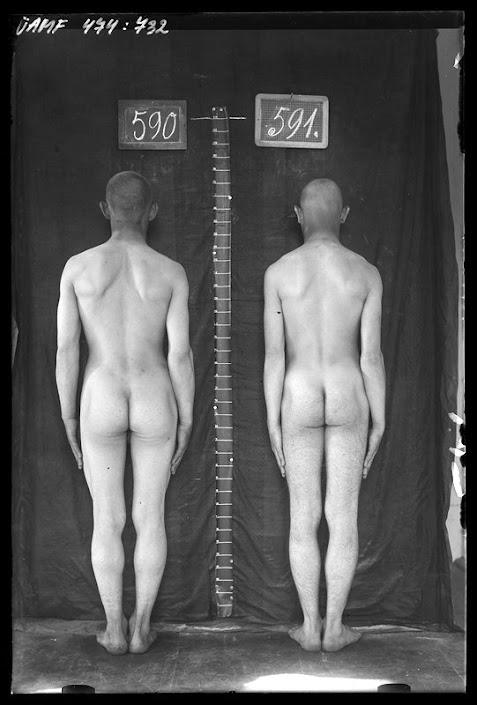Estonian Photos
Here's another group of photos from the Tartu Ülikooli museum of anthropology in Estonia.
For those who haven't seen my previous posts in this series, a few words of explanation. The museum provides no information about the men, other than the photos came from the Institute of Anatomy. In particular, it does not say who these men are, or when or why the photos were taken.
My best guess is that they are military recruits. The very short haircuts suggest that these photos were taken during or shortly after the enlistment process.
The dark faces and hands of many of the men suggests that they are either deeply tanned from working outside like farmers, or they are dirty from working in a place like a coal mine. Estonia doesn't have any coal mines, but it has oil shale mines, which would make the workers just as dirty.
When were the photos taken? My assumption has been between World War I and World War II, when Estonia was an independent country with its own military. Before WWI, Estonia was part of the Russian Empire, and after WWII, Estonia was part of the Soviet Union until 1991.
Another clue is that these photographs were made on glass plates, not film. Dry glass-plate photography started in 1871 and began to fall out of use in the 1920s. I found some references to it in Estonia through the 1930s.
Although these appear to be military recruits, these may not not be military photos. We know that the museum that currently has the photos got them from the Institute of Anatomy at the University of Tartu. If these are military photos, why would they end up at the Institute of Anatomy?
A more likely possibility is that the photos were taken by academics. Scientists at the Institute of Anatomy were doing studies to try to measure what they considered racial characteristics of the population by measuring the body, including phrenology (measuring the skull), ideas which are now discredited.
I think that the scientists at the Institute of Anatomy may have persuaded the military to let them take photographs of the naked new recruits for "research" purposes. I have no written evidence to support this idea, but since the photos were at the Institute of Anatomy, and the photo subjects appear to be military recruits, it's now my best guess as to what happened.
One other clue to the time frame of these photos is that in a previous batch, one of the men is wearing a wristwatch. Wristwatches were considered to be for ladies before World War I. (Men used pocket watches.) However, during the war, wristwatches proved very useful for soldiers and pilots. After WWI, wristwatches came into fashion for men. Although they were evidently rare in Estonia (only two men wore a wristwatch among the hundreds that were photographed), it suggests that these photos are post-World War I.
One other question that perennially arises from these photos is: why were the men photographed in pairs? Was it to save film?
The answer is that these photos were made on glass plates, which were more expensive than film, so yes, it's likely that the men were photographed in pairs to save on glass plates.
So, bottom line: My best guess is that these photos were taken after World War I, the subjects are new or recent Army recruits, and the Estonian military allowed scientists from the Institute of Anatomy to take photos of the naked recruits for "research".












3 comments:
I wonder what kind of studies can be done with photographs like these...
Taking the photos in pairs would also save time. And to the above comment regarding studies, I find them a valuable resource into the diversity of the human body. Fascinating. Thank you Mr. Unashamed Male for sharing these.
I like pictures of the average, everyday male naked. These are very simple photos but show what I like to see.
Post a Comment